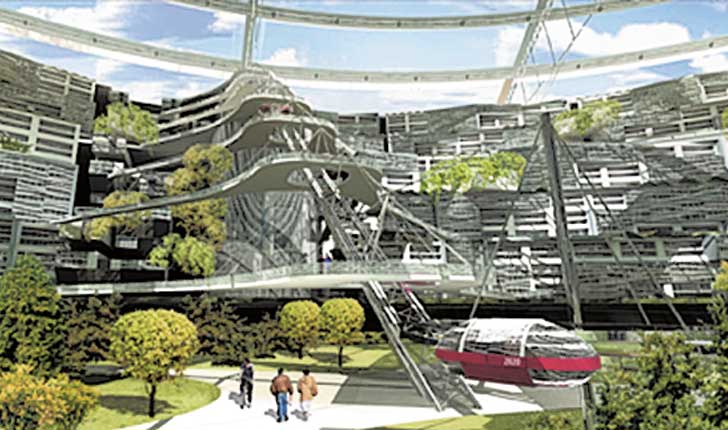A warren of streets: Eco-City 2020
As Russia plans to build a glass-domed undergound city deep beneath Siberian ice, Nick Duerden explores subterranean dwelling.

Plans were unveiled in Russia last month to construct an underground city that could become home to up to 100,000 people. Named Eco-City 2020, it would be constructed inside Siberia's abandoned Mir diamond mine, which, at a quarter of a mile wide and over 1,700ft deep, is the second largest excavated hole on the planet. The site would be covered completely by a vast glass dome, under which multiple levels would plunder its depth, with natural light piped down through the central core.
"The new city [will be] divided into three main levels with a vertical farm, forests, residences and recreational areas," said a spokesperson. "One of the most interesting aspects of the proposal is its glass dome. [It] will protect the city and be covered by photovoltaic cells that will harvest enough solar energy for the [whole] development."
The main inspiration for such a construction here on Earth rather than, say, on the moon, is meteorological: if the Siberian weather can be cruel in summer, it is unspeakably so in winter. But there is a secondary inspiration here, which rather marks its architects out as quaintly optimistic types: they hope it will also attract tourists to the region (tourists in eastern Siberia currently being somewhat thin on the ground).
Though there are doubts that such an ambitious project will ever come to fruition, underground living is hardly a futuristic whim. Jules Verne wrote about it in The Underground City back in the 19th century, and JRR Tolkien did likewise in the 20th with his hobbit holes. Churchill spent a good chunk of the Forties hiding in his below-ground War Rooms, and many plucky Londoners did similar, defying the authorities' fears that those who dwelt too long underground would turn into troglodytes. And it continues to be a popular lifestyle choice across the world today, in those communities located in extreme environments: the South Australian outback, the Berber caves of Tunisia, either Pole, and certain sections of north-west England.
Last year, developers announced plans for a £2m subterranean property in Cheshire. The plans were prompted after residents of the once discreetly upmarket area of Bowden began to complain that nothing was discreet about Bowden anymore, it having become overrun by flashy footballers trailing wives with aspirations in interior design. Build beneath the manicured lawn, ran the logic, and you could be as tacky as all hell without upsetting the neighbours.
Not so, as it transpired. Dozens of protesters called it "degeneration of the area", unsuccessfully lobbying Trafford Council to block the plans. And who are reportedly most interested in purchasing this cave-like dwelling? Footballers.
There are, of course, many obvious benefits of underground living. In a world of surprisingly regular natural disasters, it offers resistance to extreme cold and heat, and to hurricanes and tornadoes, if not quite tsunamis. A more immediate advantage is its energy efficiency. Living underground can conserve up to 80 per cent in energy costs, while solar power can eliminate energy bills in their entirety. It offers total privacy, and also a lot of quiet. The only neighbours one gets down here, separated safely by dividing walls, is insect life, and the human dead.
And though one immediately apparent downside is a claustrophobic lack of view, such problems are now circumnavigated with skylights, light tubes and virtual windows, with internet cam feeds to provide any vista that takes the owners' fancy.
Join our commenting forum
Join thought-provoking conversations, follow other Independent readers and see their replies
Comments